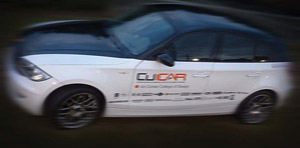firing up a cool hot car
Neil Caudle

Previous Deep Orange teams reengineered the insides of existing car bodies like the one shown below. For Deep Orange 3 the student team began with a blank sheet of paper.
Most graduate programs end with a tome for the shelf. This one produces a car. Do it right, and you can crank up your thesis and drive it around the block.
Deep Orange 3, the third generation of Clemson’s build-it-yourself master’s program in automotive engineering, is coming together on computer screens and hardware-assembly stations in a soaring, sun-filled lab at CU-ICAR, the Clemson University International Center for Automotive Research.
In the past, Deep Orange teams began with existing car bodies and reengineered the insides. This time the stakes are higher.
“The students began with a blank sheet of paper,” says Paul Venhovens, the faculty member who leads Deep Orange. “They are designing and building a car from start to finish.”
One car, two coasts
The Clemson team, now thirteen master’s students who plan to graduate in August, collaborates with the Art Center College of Design in Pasadena, Calif., where students style the vehicle’s exterior. It’s a two-year project with one car, two coasts, and two cultures.
“Working with the team in California, our students gain insight into the stylistic and emotional elements of the vehicle,” Venhovens says. “They also bring the Art Center students down to earth. It’s one thing to draw a pretty picture, another thing to turn that picture into a real, working car.”
In this case the real working car will be a sleek hybrid with all-wheel drive and room for six. The goal? A halo car—something bold enough to claim attention for the brand.
Christopher Damico, a student engineer on the project, says the team began with a study of the market, researching the preferences of Generation Y consumers aged seventeen to thirty-three. Gen Y buyers are asking for an environmentally friendly car with unique styling, excellent fuel economy, and plenty of room for friends. The buyers also want the extra traction of all-wheel drive, especially for winter driving in the Northeast.
“From the market research, we came up with hundreds of targets,” Damico says, “and we had to engineer systems to hit those targets.” One target, for example, was quick acceleration; another was fuel economy. Such targets conflict, so students learn to set aside their personal preferences and work in teams to balance the trade-offs and integrate hundreds of systems into a coherent whole.
Along the way they use a few off-the-shelf parts supplied by their sponsor—in this case, Mazda. “Why design a new radiator if you don’t need to?” Damico asks.

The schematic shows the position of drive-train elements for the team’s all-wheel-drive hybrid, scheduled to be unveiled in August.
A new kind of hybrid
The biggest innovation in Deep Orange 3, the students say, is its hybrid powertrain. Nothing like it exists on the road today.
At the moment, there are two kinds of hybrid vehicles in production—series hybrids and parallel hybrids. The Chevy Volt is a series hybrid, which means that its combustion engine serves as a generator, recharging a battery that always powers the car. The Toyota Prius is a parallel hybrid; it can send power to its drive wheels from either an electric motor or an internal-combustion engine.
Deep Orange 3 will be a new kind of parallel hybrid. Unlike the Prius, which requires an elaborate transmission system to distribute power from one engine or the other, Deep Orange 3 will drive the front wheels with a combustion engine and the rear wheels with an electric motor. An onboard computer will keep the two in sync. The team also engineered the car’s computerized battery-management system, which monitors and regulates the flow of electrical power.
“The main idea is to make a hybrid more fun, more spirited,” says Patrik Frommann, a student on the team. “We want the electric drive to support accelerating the vehicle and provide an exhilarating driving experience.”
The students say the car will be ready to roll in August, in time for graduation. Meanwhile, they refuse to divulge certain proprietary details, including the sleek wrapper being designed in Pasadena. After all, no serious carmaker gives away its secrets, and for students in Deep Orange, this is serious business.
“They begin with the marketing data and are building a new, working car from scratch,” Venhovens says. “Where else can you find an experience like that?”
Paul Venhovens is the BMW endowed chair in automotive systems integration. Mazda North American Operations is a primary corporate sponsor for Deep Orange 3. See a complete list of sponsors.


